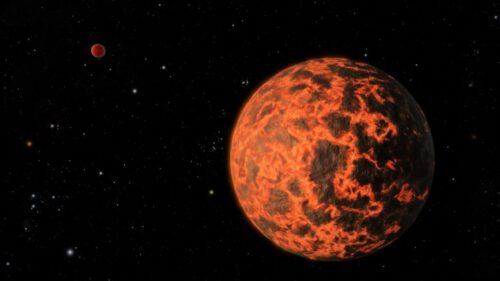A planet the size of Rahab (Neptune) may be the remnant of the core of a much larger planet
By: Jennifer Chu, Massachusetts Institute of Technology. Translation: Ziv Adaki

The "ice giants" the planets Rahab and Oron are much less dense than terrestrial, rocky planets such as Venus and Earth. Even beyond our solar system, the density of many of the Rahab-sized planets orbiting distant suns appears to be similarly low.
Now, a new planet may be breaking this trend, the planet in question was discovered by the Transiting Exoplanet Survey Satellite (TESS). The planet, named TOI-849 b, is the 749th object, or object of interest, of the Tess mission, so far identified. Researchers detected the planet orbiting the Sun at a distance of about 750 light years every 18 hours, and estimated that it is 3.5 times larger than Earth, that is, the size of Rahab. Surprisingly, the mass of this distant planet appears to be 40 times that of Earth and its density is the same as that of Earth.
TOI-849 b is a Rahab-sized planet, the most massive discovered to date and the first with a density similar to that of Earth.
"This new planet is more than twice as heavy as ours, which is a very unusual fact," says Chelsea Huang, a postdoctoral fellow at MIT's Kawli Research Institute for Astrophysics and Space Exploration and a member of the TESS research team. "Imagine a planet that has the density of Earth, made of up to 40 times more mass than our sphere. It's interesting to think about what's going on at the center of this planet, given the expected high pressure there."
The discovery was published in the journal Nature, and the authors of the paper include Huang and researchers from the Tess task force at the Massachusetts Institute of Technology.
The researchers: The finding challenges the theories about the formation of planets
Since being launched into space on April 18, 2018, the satellite has been flying scanning the sky to discover extrasolar planets. This mission is one of NASA's Astrophysical Reconnaissance missions, and is led by the Massachusetts Institute of Technology. The satellite was designed to scan almost the entire sky, by rotating its field of view on its axis each month to focus on a different area of the sky, while orbiting the Earth. As it scans the sky, Tess monitors the light from the nearest bright suns, and the researchers look for periodic dimming of the suns' pines, which might signal a planet passing by.
Data provided by Tess, the light curves of suns or measurements of light brightness, are primarily available to the international research team, in which scientists from many institutes. These researchers are the first to examine the data, with the aim of identifying promising candidates to be planets, or objects of interest for a Tess mission. These findings and the data collected in the TESS mission are shared with the entire science community to be added to and analyzed.
Usually, in their search for planets, astrophysicists focus on the closest and brightest suns in the Tess observations. Recently, however, Huang and her team spent more time examining data collected in September and October 2018, and wondered if it might be possible to find interesting findings when examining less bright suns as well. Indeed, they discovered a large number of dimmings, which look like the passage of an object on the surface of the Sun at a distance of 750 light years, immediately after, confirmed the existence of TOI-849 b. "Normally, we don't study suns like this very carefully, so this discovery is a happy coincidence," Huang says.
Additional observations of the pale sun using telescopes on Earth confirmed and confirmed the existence of the planet and helped determine its mass and density.
According to Huang, TOI-849 b's intriguing dimensions challenge current theories about how planets form.
"We are very puzzled as to how this planet formed," says Huang. "All the existing theories do not offer a full explanation of why it is so massive, but it stands. We don't expect planets to grow to 40 times the mass of Earth and then just stay put. Such a planet was supposed to continue to grow and become a gas giant, a kind of hot star, several hundred masses of the Earth."
According to one hypothesis put forward by scientists to explain the mass and density of this planet, it may have once been a much larger gas giant, similar to Rahab or Saturn - planets that have a more massive shell of gas surrounding cores, which are considered as dense as that of a sphere Country.
In the new study, the TESS mission team suggests that solar radiation may have blown away most of TOI-849 b's gaseous mantle over time—a very possible scenario, since this planet's orbit passes very close to its sun. The eclipse lasts only 0.765 days, or just over 18 hours, and thus the planet is exposed to solar radiation that is about 2,000 times stronger than the Earth is exposed to from the Sun. According to this model, the planet TOI-849 b may be the core remnant of a giant planet, which is the size of Rahab and is much more massive than it.
"If this scenario is true, TOI-849 b is the only core remnant and large gas giant core that we know of," says Huang. "This is very exciting among scientists, because previous theories cannot explain this planet."
For the scientific article:
Reference: "A remnant planetary core in the hot-Neptune desert" by David Armstrong et al., 1 July 2020, Nature.
DOI: 10.1038/s41586-020-2421-7

3 תגובות
Nibiru?
If it is true that the gas that surrounded the core evaporated because of the sun why did the mass remain as it was before
excitement….